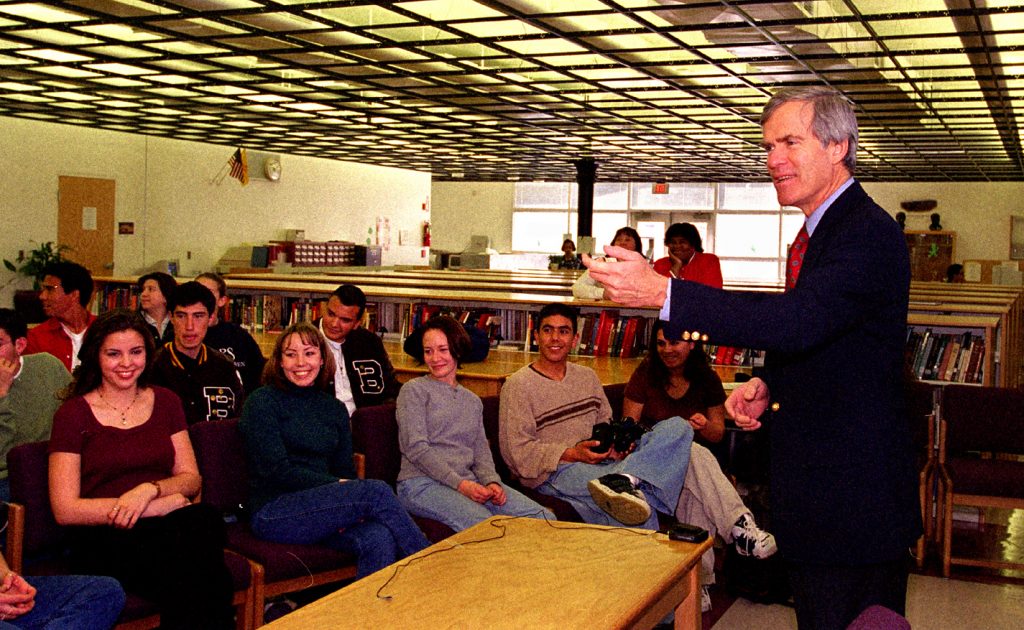
Download 150dpi JPEG image, ‘BHsecur1.jpg’, 1.3Mb
ALBUQUERQUE, N.M. — Sen. Jeff Bingaman, D-N.M., today named Sandia National Laboratories to head a new national center of expertise for school security technologies and approaches. Bingaman plans to introduce Congressional legislation establishing the center next week. He announced his plans today at Belen High School in Belen, N.M.
Efforts to improve security on the nation’s school grounds have intensified since the fatal shootings of three students by a classmate at Heath High School in Paducah, Ky., on Dec. 1, 1997. Bingaman’s legislation supports President Clinton’s ongoing school safety initiative as well.
The School Security Technology Center would help make the nation’s school grounds safer for thousands of students by improving security on hundreds of elementary, middle, and high school campuses. It would serve as a resource for school security professionals and administrators on how technology can be used to solve such on-campus problems as violent crime, theft, vandalism, and drug and alcohol use.
The Center would draw on Sandia’s decades of experience designing security systems as part of its Department of Energy mission to protect materials vital to U.S. national security. In recent years, Sandia also has applied that experience to deterring crime on school campuses and protecting school assets from vandalism and theft using proven technologies and sound security principles.
The turn-around of Belen High School
In spring 1996, Sandia scientists advised Belen High School administrators, parents, teachers, and students on technologies and approaches that would most effectively address a variety of problems at the school, then helped implement the changes over the summer. By the following summer the school reported a 90 percent decrease in vandalism and theft, 75 percent fewer fights on campus, and 95 percent fewer false fire alarms, among other improvements. Sandia has conducted similar vulnerability assessments at dozens of other New Mexico schools as well.
The bill, called the Safe Schools Security Act of 1998, would provide Sandia with $1.4 million per year for three years to expand its programs to advise and train school administrators and help schools choose security technologies and measures that most effectively deter crime and protect school assets. The bill also would provide $10 million per year to help selected schools purchase appropriate security technologies.
“The Center would allow Sandia to partner with hundreds of schools nationwide on something that is a concern of every family in America,” says Mary Green of Sandia’s Security Systems and Technologies Center. “While Sandia doesn’t have the answers to all the problems, we think we can help schools determine where technology can be an important part of the solution.”
Schools often don’t have a lot of money, adds Green, so part of the Center’s role will be evaluating new security technologies for use in schools and advising administrators on practical, common-sense solutions to security problems on a school-by-school basis. Affordability will be a primary issue.
At Belen High School, for instance, implementation of a closed campus and minor physical enhancements to the school’s grounds complemented installation of video surveillance and sensor systems.
“In many cases the best solutions to a school’s problems can be remarkably simple, nontechnical, and even inexpensive,” she says.
The Center also will advise schools on the limitations, maintenance requirements, costs, and public perceptions of technology, as well as civil rights and privacy issues that some technologies present.
‘How-to’ manuals on solving the most common problems
Sandia now is working on a set of “how-to” manuals to help administrators self-assess and solve some of the most common school security problems. When the project is complete, Green hopes to put into the hands of interested principals and superintendents a set of three succinct, user-friendly manuals, one focusing on solving each of the following problems: violence, vandalism and theft of school property, and drug and alcohol use on campuses. The National Institute of Justice is funding the manuals’ development.
The School Security Technology Center would be located in Albuquerque near Kirtland Air Force Base. Initially Sandia would operate the Center but would seek to transfer responsibilities gradually to a not-for-profit entity staffed by experienced school administrators and school security professionals. The independent Center would continue to draw on Sandia’s expertise and work cooperatively with the Departments of Justice, Education, and Energy.
Technical contact:
Mary Green, mgreen@sandia.gov, (505) 844-7746